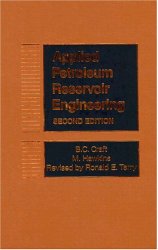Engineering Bookshelf
- Aerospace
- Biological
- Civil
- Chemical
- Environmental
- Electrical
- Materials
- Mechanical
- Petroleum
- Geoengineering
- Software

Applied Petroleum Reservoir Engineering
by B. C. Craft, M. Hawkins, Ronald E. TerryPublisher: Prentice Hall
ISBN: 0130398845
Check price @ amazon.com , amazon.ca , amazon.co.uk
Book Descriptiion
The most current, applied book on the market for petroleum engineers, geologists and others working in the development and production of oil and gas fields and those concerned with the movement of ground water, this revised edition reflects the advances made in reservoir engineering calculation techniques. Numerous real world examples clarify the material, providing the reservoir engineer with the practical information to make applied calculations.
Customer Reviews
By Eloy Villanueva
The content of the book is great. It covers the fundamental ideas behind oil in place calculations, the reservoir production mechanisms, and the material balance equation. There's great exercises at the end of the chapters but sadly no answers for any of them. The previous edition does have selected answers. The binding is terrible. I have a few weeks with the book and the pages just fall off. They simply fall off, like if the glue was so scanty.
By Leopoldo Farias
This is one of the traditional textbooks of reservoir engineering that has survived the pass of time because of its undoubtful quality. The book has a considerable number of solved and proposed exercises and the subjects are presented in a manner very easy to understand. It was originally written at the time in which material balance calculations were the basic algoritm used by reservoir engineers to characterize hidrocarbon reservoirs. As such, this book is organized in terms of the material balance equation: it goes from material balance applied to dry gas, the next chapter is about material balance applied to gas-condensate, then undersaturated and so on, until all diferent fluids are covered. A variety of procedures to do the material balance calculations are presented, many of them of little or no usefulness today and definitely not even mentioned in modern reservoir engineering courses. Important topics such as PVT are dispersed in all the chapters. Other such as pressure testing and inmiscible displacement are covered without adequate depth. Numerical simulation is not even an entry in the subject index. In summary, if your interest is to read about material balance methods in reservoir engineering, this is the book to pick. If you are seeking a general view of the subject then there are better options.